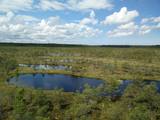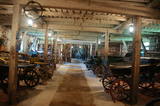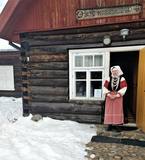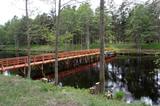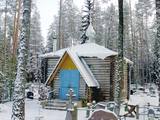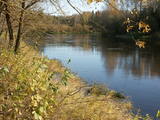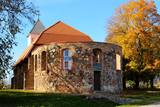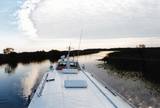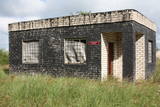| Nr | Name | Beschreibung |
|---|---|---|
|
This is one of the largest high-type swamps (6,192 ha) in Latvia, with very distinct landscapes of little lakes and hillocks. The Great Ķemeri Heath is of importance as an extensive hydrological system and preserver of the local microclimate. It is also of international importance as a site for birds, as well as a major source of sulphurous water. Along the Kalnciems-Kūdra road, which is on the eastern edge of the swamp (3.4 km from the Rīga-Ventspils highway), there is an information stand with information about the management of the heath and about the role of swamps in nature and in the lives of people. Great Ķemeri Heath wooden pathway trail is now restored and opened for visitors in 2013. |
||
|
Taka iesākumā ved pa mežu ieskautu bijušo šaursliežu dzelzceļa līniju, pa kuru pagājušā gadsimta vidū izveda kokmateriālus. Tās tālākā daļa izmet nelielu loku pa Suistna purvu (Suistna raba), kur uzcelts skatu tornis ar izcilu sūnu purva ainavu ar nelieliem ezeriņiem. Takas garums vienā virzienā ir 4,5 km. |
||
|
Das Museum für Pferdewagen befindet sich im Beigut Pilkuse. Zu den Exponaten gehören Pferdewagen und -schlitten sowie Zubehör (Krummhölzer, Kummet, Schellen, ebenso Schlittendecken und Moorschuhe für Pferde). Hier sind Kriegs-, Nothilfe- und Feuerwehrwagen. Perlen des Museums sind eine Kutsche und eine Kalesche, darüber hinaus gibt es viele Feldgeräte. Es gibt viele sehenswerte und interessante Exponate |
||
|
You can go fishing in five fish ponds and then dry the fish. The owner prepares hot-smoked trout, dried carps, and fish soup cooked on a campfire. You can also buy chicken eggs. |
||
|
While you are in Obinitsa Seto Museum you can learn more about the lifestyle and culture of Setomaa's people. In the museum you can see a lot of items that are very important to their culture, for example the fine handicraft of the Seto women. Also since 2015 here you can also learn about other Finno-Ugric nations. There is a possibility to shop in the souvenir shop. |
||
|
Eine kleine Bierbrauerei und ein Laden in Lielvārde. Es werden Verkostungen organisiert sowie angeboten, in Lettland hergestellte Köstlichkeiten vor Ort zu probieren oder zum Mitnehmen zu kaufen. |
||
|
Die sagenhaften Blauen Berge von Šlītere sind schon seit alten Zeiten bekannt, als Seeräuber dort betrügerische Feuer gemacht haben, damit die Seeleute mit ihren Schiffen auf die Sandbänke des Kaps von Kolka fahren. Heute nennt man die Küste des Nationalparks Slītere bildlich als das Freilichtmuseum für Geologie der Ostsee, weil man hier das ehemalige Ufer des Baltischen Eisstausees, des Ancylussees und Dünenbildungen (Kangari, Vigas) besichtigen kann, die deutlich die Entwicklungsgeschichte der Ostsee zeigen. Dieses Gebiet haben früher die Liven bewohnt, deren Fischerdörfer als der Ort der Kultur einer der kleinsten ethischen Gruppe der Welt bedeutend sind. Die Route führt auf der Strecke von Kolka bis Mazirbe auf der alten Küstenstraße, die sich durch die Dörfer der Liven windet. Der Nationalpark Slītere ist eines der pflanzenreichten Gebiete Lettlands, aber das Kap von Kolka – einer der bekanntesten Orte zur Vogelbeobachtung. Route information from Latvijas Lauku forums |
||
|
The cafe is situated in the shopping centre Sala in Jekabpils, on the right back of the river Daugava. The cafe’s premises are comfortable and decorated with fresh flowers. It is a place where you can have either breakfast, dinner or supper. Working hours: 9.00 - 20.00 |
||
|
The fisherman offers you a chance to engage in string-based fishing at the seashore near Nida and Pape, fishing out in the sea (1-2 people), and ice fishing during the winter. You can smoke what you catch or cook fish soup with it. |
||
|
This is an artificial body of water that was dug in the 1960s to obtain ice for fish processing plants in Kolka. |
||
|
Meldegängerabteilung Knīpupji in Wälder von Bārta ist verlassen worden und sie wird nicht bewirtschaftet. Ein degradiertes Objekt. Die Gebäude werden zum Zweck Baustoffe – Gewinnung demontiert.
|
||
|
Bauernhof Maizes māja in der Nähe von Cēsis, wo man Genuss, Kraft und Lebenskunst erhalten kann! Es werden Piroggen-Partys und Brotback-Events; Vorstellung der Bäcker- und Kochberufe; Lebensfähigkeiten und Naturabenteuer; traditionelle und Jahresfeste; Feiern in der alten Kornkammer organisiert. Schüler, Familien, Freunde und Touristengruppen werden in „Maizes māja“ für eine Weile zu Mitgliedern des Haushalts: Dabei haben sie viel zu tun – das Brennholz muss getragen, der Ofen geheizt werden und in einem echten Brotofen wird Roggenbrot oder süß–saures Brot aus Kaupo–Roggenmehl gebacken |
||
|
The guest house is located in Odziena, Vietalva Parish, Plavinas Region. The house has 5 bedrooms, guests can enjoy a sauna, a pool and a swim in the pond, as well as fishing. There is a large surrounding area for organizing activities and other classes - the guest house is suitable for both relaxation and celebrations. |
||
|
All Saints Orthodox Church of Malta (Rozentova) was built in
1928. It is the wooden log building with double window frames and a
dome. Facades are decorated with the motive of the sun.
|
||
|
Traķu pirmsākumi ir meklējami Senajos Traķos, kas atrodas 4 km dienvidaustrumos no Traķu centra. Uzskata, ka Senos Traķus ir dibinājis Lietuvas dižkunigaitis Ģedimins (~ 1275. – 1341.) 14. gs. pirmajā pusē. 14. gs. otrajā pusē šeit uzcēla mūra pili, no kuras līdz mūsdienām ir saglabājušies tikai nostāvināti zemes vaļņi. Laikā no 1345. – 1382. g. tajā valdīja Ģedimina dēls – Ķēstutis (1297. – 1382.). Senajos Traķos dzimis arī viens no izcilākajiem viduslaiku Lietuvas valdniekiem – Ķēstuta dēls - Vītauts Dižais. Kā pilij, tā arī tās valdniekiem bija nozīmīga loma sekojošajos krusta karos un cīņās. 1391. g. pils tika sagrauta cīņas laikā ar Vācu ordeni, kādēļ arī zaudēja savu stratēģisko nozīmi. 1405. g. benediktīniešu mūki šajā vietā uzcēla baznīcu, bet 18. gs. beigās - jaunu un lielāka apjoma klosteri, kura vienu no korpusiem 1889. g. pārbūvēja par baznīcu. |
||
|
Das Café befindet sich am Rande der Straße Riga – Liepaja (A9). Weite Räume, Innenausstattung aus Holz. Lettische Küche: Quark mit Hering und Sauerrahm, Bauernfrühstück, Steinpilzsuppe, in Zwiebeln gebratenes Schweinefleisch, geschmorte Leber, hausgemachte Frikadellen, gebratene Schweinerippen, Kartoffelpfannkuchen, gefüllte Pfannkuchen. Das besondere Gericht: Schinkentopf Jumis. |
||
|
Teritorija, kas aptuveni 20 km garumā „piekļāvusies” abiem Aiviekstes upes krastiem. Dabas parka galvenā vērtība ir palieņu pļavas (un citi pļavu biotopi), kas ir ļoti nozīmīga daudzu augu un dzīvnieku (īpaši – putnu) sugu dzīves vieta. Ūdenstūristiem, kas laivo pa Aivieksti, nakšņošana ir jāplāno tikai šim mērķim paredzētās vietās!
|
||
|
Dievnama mūri kā svētvieta glabā ne tikai svētuma starojumu, mierinājumu, bet arī smagus, rūgtus un iznīcinošus notikumus. Vairākkārt pārbūvēta, sagrauta, dedzināta, un tomēr atjaunota. |
||
|
This is a quick boat ride from Tartu down the Emajõgi River to Piirissaare Island in Lake Peipsi (Peipsi järv). Along the lower reaches of the river are major wetlands which are of enormous importance for birds.
|
||
|
In der Zeit der Sowjetunion befand sich die radiotechnische Kompanie von Lūžņa im Bestand von der Küstengrenzwache. Eine sehr gute Aussicht auf den ehemaligen Militärkomplex von dem Parklpatz im Zentrum von Lūžņa aus. Manche Gebäude werden als Wohngebäude genutzt.
|
||
